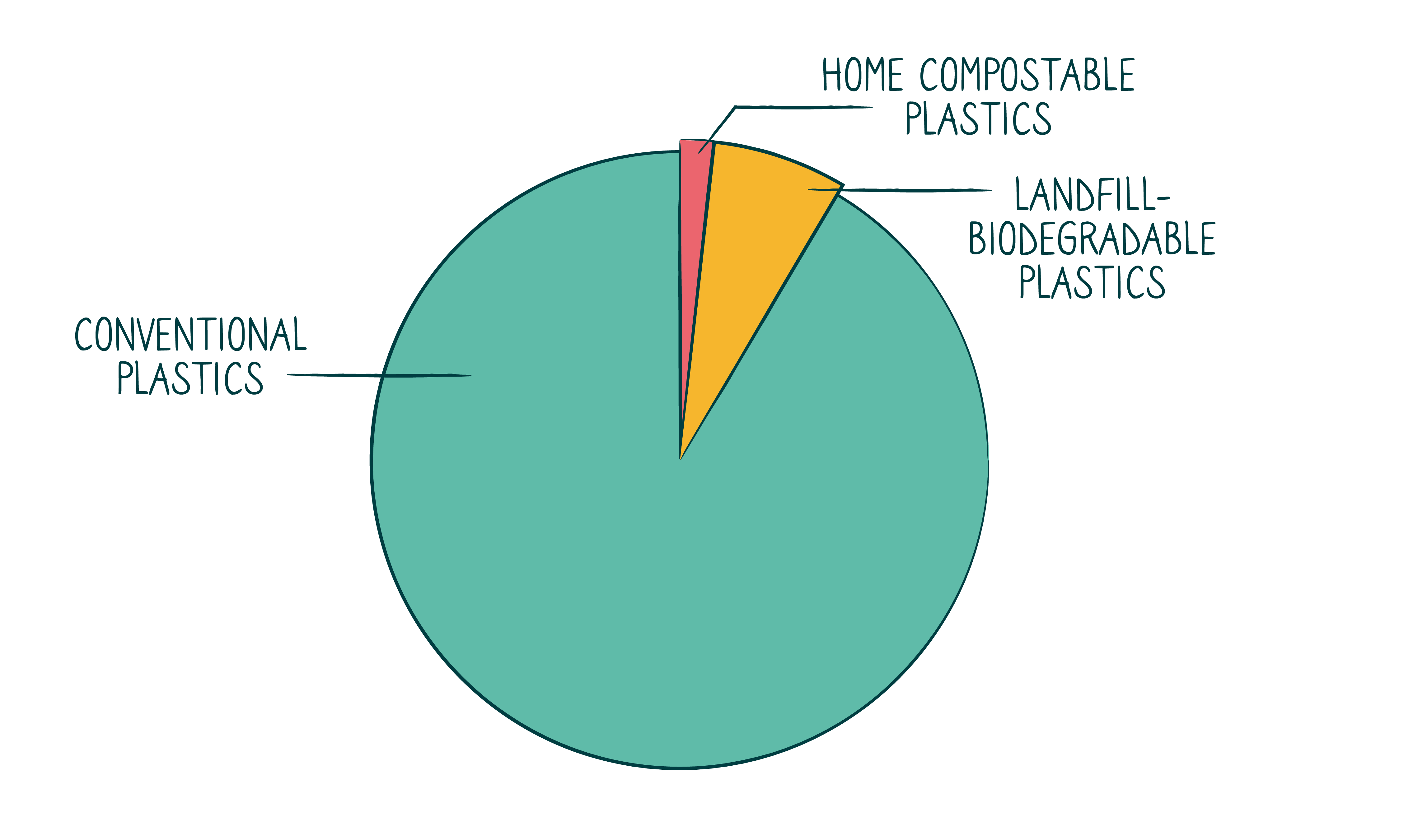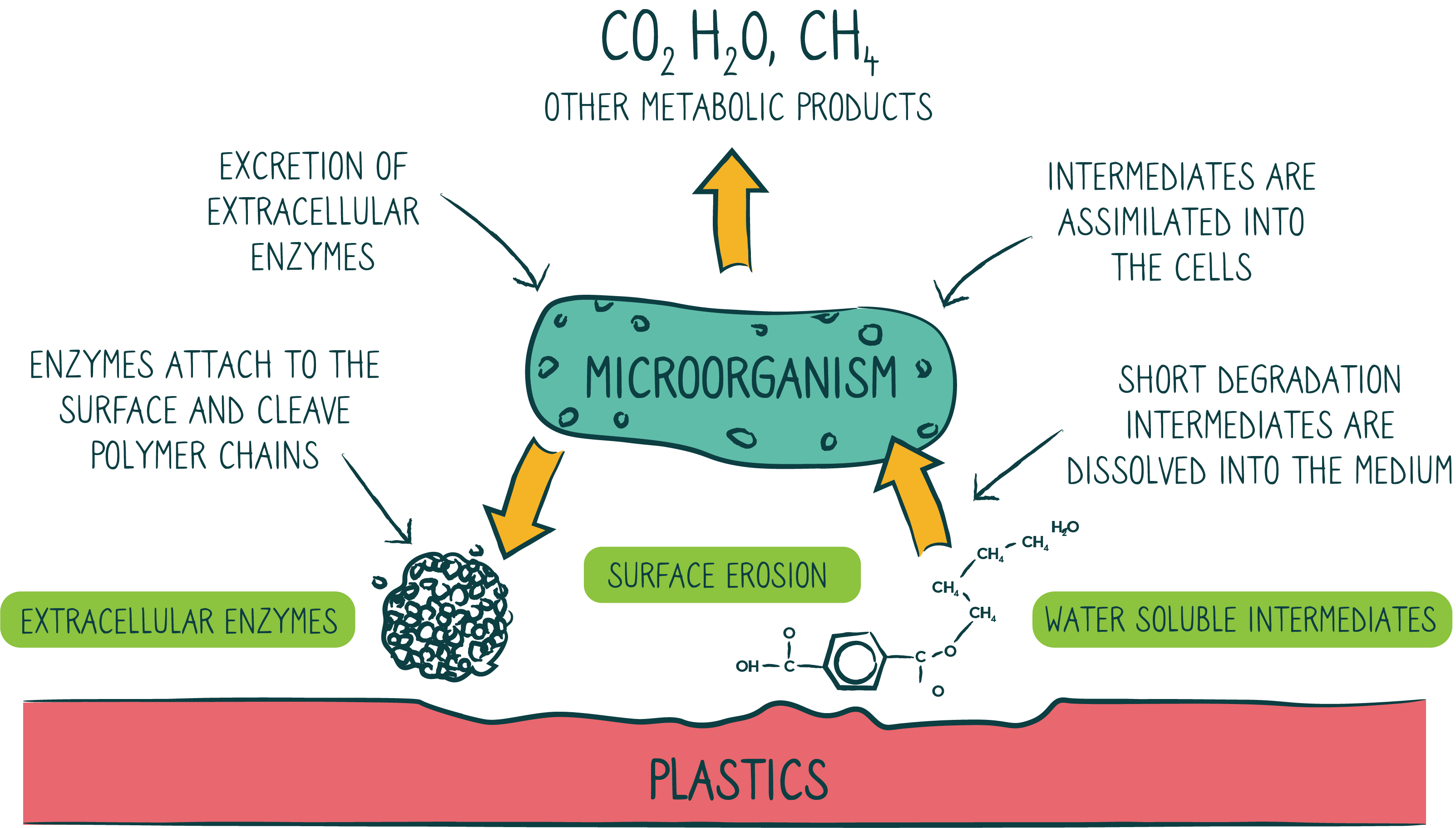FAQ's & Resources
When it comes to biodegradable plastics, the 2 main choices are:
1. Landfill-biodegradable (which is our choice)
2. Compostable (home or commercial)
How long it takes to biodegrade

Biowrap understands
– Single-use plastics are not going anywhere any time in the future
– 90% of plastic waste currently is disposed of in landfills
– We’re years off having a complete and functional circular economy.
– Some consumers are time poor and often choose the most convenient option
– Most consumers dispose of their waste (including single-use plastics) – more often than not in landfill
(where else can you put your rubbish bin bags!)
– All commercial compostable products need to be deposited in commercial composts
(which is a waste stream that is not available in most local councils across the country).
Hence many ‘compostable’ items end up in a landfill
– Commercial compostable plastics need very specific environments to biodegrade
– Many people don’t have a home compost for them to dispose of their home compostable plastic items
Biowrap offers the logical solution
Landfill-biodegradable plastic products:
– Are affordable and a practical solution
– Are all about ‘convenience’ and designed for ‘time poor’ consumers
(who are mindful of their impact on the environment)
– Can be either reusable or recyclable
– Biodegrades 90%+ faster than conventional plastics, biodegrading under typical landfill environmental conditions
(much faster than traditional plastics which take hundreds of years to biodegrade)
– The methane produced from accelerated landfill-biodegradable plastics can be captured within the time frame the landfill is actively managed,
rather than being released into the atmosphere over hundreds of years after the landfill has closed and stopped being managed.
This captured methane can be used for fuel and energy production
– Biodegradation of plastic is achieved by enabling microorganisms to metabolize (i.e. break down) the molecular structure of the plastic,
which produces a humus-like material (organic matter) which is a natural plant fertiliser and a biogas
– Do not fragment into microplastics during biodegradation
Landfill-biodegradable technology
Landfill-biodegradable products are made by combining traditional plastic with an organic additive. The biodegradation only begins when the plastic is exposed to a microbe-rich environment, such as a modern municipal landfill. The additive attracts microbes to the plastic and they start to digest it. As they do this, the enzymes (the microbes secrete) break the carbon bonds in the plastic molecule allowing non plastic intermediaries to lift off. The microbes can digest these for their energy. As more enzymes are secreted, more intermediaries are removed from the plastic molecule (called depolymerisation) which the microbes can digest. As this process continues, the plastic molecule is broken down and digested away.
The biodegradability of plastic can be confirmed by comparing biodegradation results from an independent laboratory using either ASTM D5511, ASTM D5526 or Bio-Methane Potential (BMP) tests.
This diagram illustrates the additive and the landfill-biodegradable process

FAQ
Landfill-biodegradable is a true biodegradable approach, where the plastic features an organic additive, which accelerates the rate at which plastics will biodegrade, by allowing naturally occurring bacteria to consume the plastic in a landfill environment, resulting in biogas and humus (natural fertiliser). It also does not fragment into microplastics. Only ‘degradable’ or ‘oxo-degradable’ plastics fragment, which is a concern as it leaves microplastics in the environment.
If it cannot be recycled then landfill-biodegradable plastics should be disposed to a general waste bin where it will go to a managed landfill.
Yes. However our method allows the methane produced from landfill-biodegradable plastics to be captured within the time-frame the landfill is actively managed, rather than being neglected and released into the atmosphere for hundreds of years after the landfill has closed and stopped being managed. The methane captured can be used for fuel and energy production displacing energy from coal combustion.
Landfill-biodegradable uses a proprietary organic additive added to conventional plastic material. This additive draws microbes in a modern landfill to the plastic. In eating it, they secrete enzymes which break down the plastic molecule to the point where it too can be digested. The additive effect only comes into play when the plastic product is disposed of in a microbe-rich environment, such as a modern municipal landfill. Depending on the plastic thickness it can take a few years or 10’s of years to biodegrade; making it suitable for landfill gas recovery and making Biowrap the logical choice for everyday plastic.
Biowrap uses a organic additive, which is:
- An organic food source.
- Approved by USFDA for food contact.
- Mixed in a small ratio to not affect the parent plastic material properties.
Yes, the biodegradable plastic is very safe. In fact, food packaging film made with the additive is USFDA compliant for food contact applications.
Yes. Landfill-biodegradable products are currently used in 25 countries across the world.
Currently, there is no regulating body for this technology in New Zealand or Australia and we are unable to provide any certificate as not one exists. Nevertheless, we can provide third-party lab test results that prove accelerated biodegradation under anaerobic conditions (ASTM 5511) and BMP (Biochemical-Methane Potential).
Yes. With so many manufacturers and retailers offering ‘green’ products, it has become confusing to distinguish between what is a genuine biodegradable product, what is a compostable product, what is a degradable product, and what are unsubstantiated claims. We have ASTM and BMP tests, which are recognised internationally as being the benchmark of verifications. The ASTM D5511 is a test performed by an independent laboratory that measures the carbon released from the plastic as a biogas to verify claims of biodegradability in anaerobic conditions, intending to replicate conditions found in a typical landfill.
The BMP (Biochemical-Methane Potential) lab test data is used internationally by governments, universities and commercial operators to determine the true biochemical methane potential and dynamic degradation profile of a material in anaerobic conditions. The test validates our landfill-biodegradable plastic can be digested by microorganisms within an environment with no/limited oxygen and limited light.
No. There is no toxic residue when the biodegradable plastic decomposes. Plastic such as polyethylene break down to CH4, C02 and organic matter.
No. It has no shelf life or expiry dates and will only biodegrade when disposed of in a landfill.
No. Landfill-biodegradable plastics will biodegrade in a modern landfill and require no light or oxygen.
No. Landfill-biodegradable is a proprietary organic additive added to conventional plastic material. The additive only comes into play when the plastic product is disposed of in a microbe-rich environment, biodegrading into organic matter-producing natural fertiliser. Our landfill-biodegradable products do not feature any degradable additives and will not fragment to form microplastics. We do not use or support degradable/fragmentable additives.
The biodegradation time of a product depends on a variety of factors. The landfill-biodegradable additives will make plastic biodegrade approximately 90% faster than conventional plastics (years to decades) – keeping in mind many conventional plastics will take hundreds of years to biodegrade. It all depends on the following variables:
- Landfill conditions are different across the country. Some are in cooler or warmer conditions. If the plastic is put into a dry landfill it will degrade slower than a more actively managed modern landfill.
- The difference in plastic thickness. Our landfill-biodegradable plastics vary in thickness. The thicker the plastic section, the longer it will take to biodegrade. Membrane films are expected to biodegrade quickly. Thicker sections may take several years.
The main point is whether it takes a few months or multiple years doesn’t really matter. What does matter is that after some limited time, the product will completely biodegrade into biogas and a natural fertiliser – we are no longer leaving our plastic waste for future generations to deal with, and the biogas can be captured and utilised by the landfill within the timeframe that it is actively managed.
No. They are very different processes. As its name infers biodegradation is a biological process, and is the breakdown of plastic material caused by naturally occurring microorganisms such as those occurring in a modern landfill. Degradable plastic is a plastic with a metallic additive that sets off a slow chemical reaction and over 12-24 months will cause the plastic to fragment into little pieces. This has nothing to do with biodegradation and microorganisms. Also, the reaction will only work in the presence of oxygen and sunlight. So if a degradable plastic is buried in a landfill where there is no sunlight and very little oxygen, it will stay there like a conventional plastic not degrading. Therefore for a degradable plastic to fragment down into little pieces it has to be up on top of the ground and there those little pieces will blow around and disperse into the environment. Our landfill-biodegradable products do not contain any degradable additives (prodegradants) and do not fragment down to microplastics. We do not use or support oxo-degradable / fragmentable additives.
Compare the plastic technologies
| Plastic Property | Landfill-Biodegradable | Home Compostable | Compostable | Oxo-Degradable |
|---|---|---|---|---|
| Biodegradable in landfills? | Yes | Yes | No | No |
| Recyclable with other mainstream plastics? | Yes | No | No | No |
| Special storage conditions required? | No | Yes | Yes | Yes |
| Shelf life / has expiration dates? | No | Yes | Yes | Yes |
| Will degrade over a few months when exposed to sunlight | No | Marginally | Marginally | Yes |
| Fragments into small pieces in ambient air | No | No | No | Yes |
| Biodegradation begins at time of disposal; not before | Yes | Yes | Yes, in Commercial compost facility only | No |
| Will biodegrade in commercial and home composts | No | Yes | No, Commercial compost facility only | No |
| Needs oxygen in order to biodegrade | No | No | Yes | Yes |

